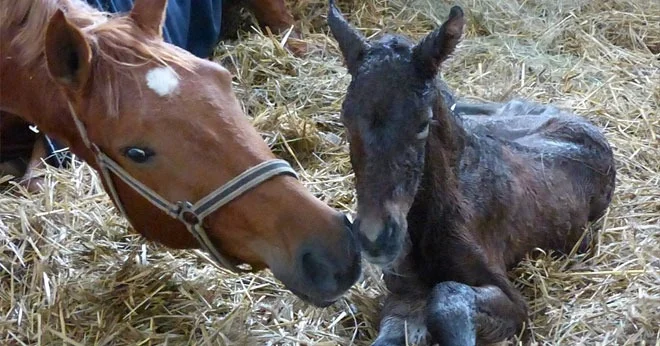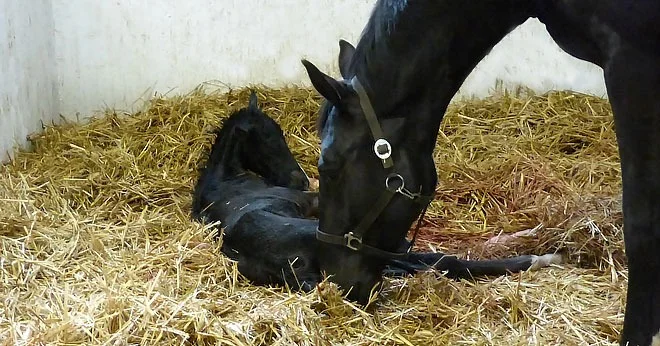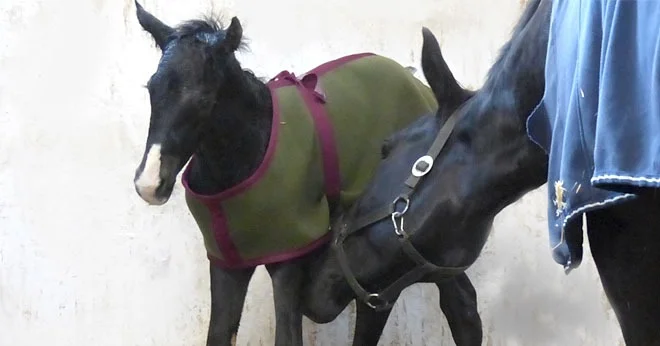Knowledge
Practical knowledge from passion – directly from Dree Böken
Our stud has been a trend setter in breeding and management of horses for many years. We have developed quite unconventional ideas that have at a later stage been implemented in many leading studs around Germany. For example, our stud was one of the first to implement a concept of open stables and group housing of horses.
Our experience and a lot of practical ideas generated in decades of horse breeding and management are included in our book (available in German only). Below you will find some selected topics that might be of interest.
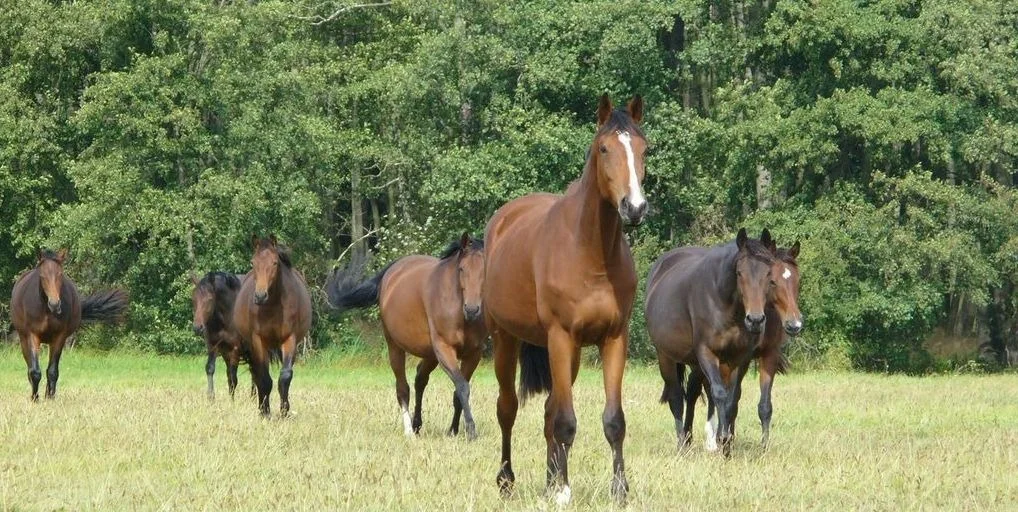
Careful planning for healthy foals
Insemination
All mares are in perfect nutritional condition before the insemination, based on an appropriate individual basic diet and sufficient supply in minerals. Uterine swabs are taken to ensure that the mares are clean.

Own herd insemination
Above-average pregnancy rates
We always try to obtain fresh semen for which long distances have to be covered sometimes. If possible, the mares are inseminated on our farm (own herd insemination), always after the follicle control has shown that ovulation is imminent. We achieve above-average pregnancy rates with consequent follow-up vet checks and excellent quality of sperm.
Over the years, our experiences with the sperm quality have been different and sometimes not satisfactory.
Our pregnancy rate amounts normally to 90%.
A powerful start to life
Feeding and management during pregnancy
An individual, appropriate feeding with a sufficient supply in vitamins, minerals and trace elements as well as deworming and perfect care is also of tremendous importance during pregnancy, particularly when focusing on the healthy development of the foals and their later top performances. In this respect, full consideration is given to soil testing, examinations of the basic diet and the recommendations of the consultancy company Schade und Partner. As we think that deficiencies at this stage may form the basis for damages at the advanced age.
The birth process
Foal birth
Mares showing signs of impending parturition are equipped with a monitoring device (Wächtomat) and a video camera. We accompany the birth process and assist foal and mare as much as is required until the foal approaches the udder.
Deworming and immune defense
After the umbilical cord was torn, the navel is disinfected and the foal is administered an enema to ensure that it easily releases the meconium . To improve immune defense, it is also administered 2 ml Zylexis. Tail and udder of the mare are cleaned, the first colostrum is complemented by 10 ml Haemolytan and administered to the foal. This special procedure, also available as check list, ensures the foal's perfect start to life.
Raising foals and young horses
Gentle method
Weaning a foal can result in tremendous stress that easily leads to after-effects and depression. In order not to jeopardize the foal's self-confidence, we proceed according to the so-called "gentle weaning method" which means that we do not separate foal and mare, but the mare from the herd.
If the foals are +/- three weeks old, they join the group of other broodmares – spending their time in run-in stables during the night and on pasture during the day.
Once the foals are +/- 5 months old and provided they have developed well, they will be separated from their dam. The foals stay with the group between the other foals in their well-known surrounding. The dam will be separated from the group. The first three to four days after the weaning, the foal will spend a short time with its dam in the morning and in the evening to suck once again and to help to keep the mare's udder from getting too full. Immediately after the sucking, the foal will return to its group. This way, weaning is effected without any problems and almost stress-free for the foal.
Horse-appropriate husbandry
We attach greatest importance to a horse-appropriate husbandry when raising young horses.
The foals and young horses until the age of two as well as the broodmares are kept on pasture and in run-in stables in groups with lots of movement, well-balanced diets, best air conditions and regular deworming. The horses are tied twice a day while feeding concentrated feed. This regular body contact twice a day increases confidence and tremendously supports the development of character and personality of the horse. It is an investment for the whole life of the horse!

Solid, natural raising
In general, the young horses spend their second summer in the marshlands of the river Weser on solid, not over-fertilized pastures which results in strengthening the immune system and the general vitality of the horses. A solid and natural raising method – combined with constant human contact – is a valuable investment into the future of the horses. This method is worthwhile in regards to development of the foundation and organs, it is strengthening bones and legs and fosters toughness, health, resilience and longevity.
The training of the young horses
When raising and training the young horses, they are particularly carefully prepared for their later use as competition horse. This is to ensure that the horses gain confidence, that they are easy to handle and willingly working. They are meant to give their new future owner lots of pleasure!
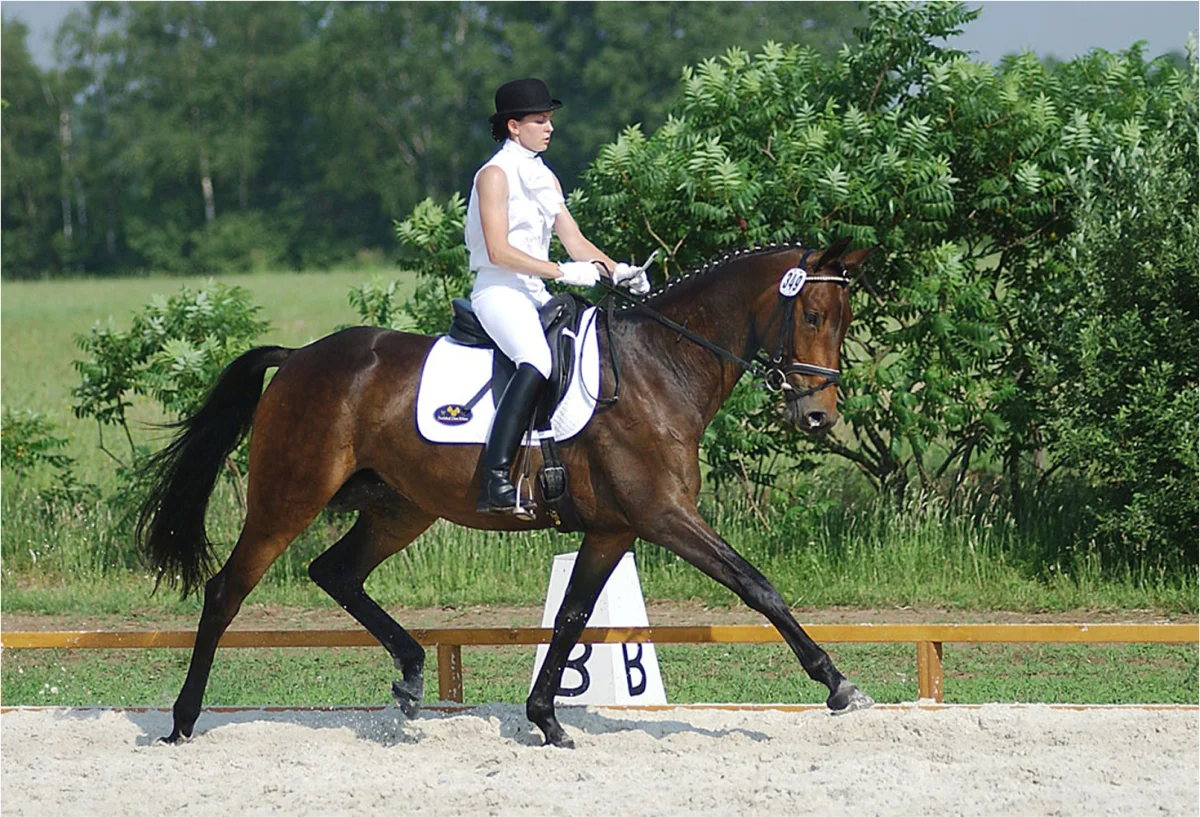
Imprinting and habituation
Teaching the young horses already starts the first days of life with imprinting of the foal, regular tying up, hoof care and loading training on a trailer. Basic riding training is done on our farm, with lots of time, in a calm atmosphere, with love and devotion to further consolidate the character of the horses. This way, all our horses are easy to handle, and they are good with the farrier and can be easily loaded.
As soon as the horses are two years old and before they are turned out to summer pasture, they are worked at the lunge every day for approx. four weeks. If they have settled with the training, beginning with the third week, we also put a saddle on without stirrups.
The following autumn, starting +/- October, we restart the work at the lunge including saddle and smoothly start the young horses under saddle. The first thing the young horses are meant to learn only is to accept the rider sitting on its back – not more in the beginning. We particularly work with long reins.
Preparation for mare performance tests
Our young mares will have a foal first and are then inseminated a second time. Following the weaning of the foal, the riding training is continued and the mares are prepared for their mare performance test. These are our raw diamonds.
Health and care
Deworming
Stool samples are taken every year, predominantly with the young horses. We take stool samples of each herd as collective sample. Provided a horse shows signs of health problems, individual sample are taken. The dewormer is chosen correspondingly. Foals aged seven months and younger are dewormed every four weeks, all other horses mid of December, mid of April, mid of July and at the end of October.
Vaccination
Herpes and influenza: All horses are regularly vaccinated against influenza and equine herpes. The foals are vaccinated the first time at the age of approx. eight months with a follow-up vaccination after approx. six weeks. Then the same time interval as with the elder horses is applied. Tetanus: first vaccination with the foals as is done with herpes and influenza at the age of approx. eight months. Follow-up after six weeks. Then every second year on December 30.
Hoof care
All hooves are trimmed and checked every eight weeks and – if necessary – the horses are shoed. The hooves of the foals are also regularly checked to ensure a perfect, well-balanced and straight position of the hooves. Every four weeks until the seventh or eighth month, then like with the elder horses. Provided hoof care is neglected, misalignments may be the result very quickly. Later and sometimes not explainable lameness are frequently the result of inferior hoof care and misalignments in the horse's youth.
Vet treatment
When it comes to equine husbandry, we stick to the official regulation published September 24, 2002, on the obligation to produce proof of administered drugs.
Our opinion: Provided care and feeding conditions are perfect, no horse needs any medicine. Important: Excellent stable climate (light, air, sunshine, appropriate size of stalls, excellent pastures, individually adapted feeding at regular times) and individually adapted deworming and lots of movement.
Quarantine
Increased caution with horses that spend time in a different stable – whether for breeding or sports purposes. In such a case, we try to separate the horses at least two weeks from the herd.
